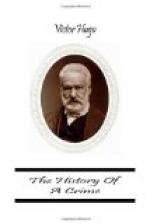This page written, I went to bed, and fell asleep.
THE THIRD DAY—THE MASSACRE.
CHAPTER I.
THOSE WHO SLEEP AND HE WHO DOES NOT SLEEP
During this night of the 3d and 4th of December, while we who were overcome with fatigue and betrothed to calamity slept an honest slumber, not an eye was closed at the Elysee. An infamous sleeplessness reigned there. Towards two o’clock in the morning the Comte Roguet, after Morny the most intimate of the confidants of the Elysee, an ex-peer of France and a lieutenant-general, came out of Louis Bonaparte’s private room; Roguet was accompanied by Saint-Arnaud. Saint-Arnaud, it may be remembered, was at that time Minister of War.
Two colonels were waiting in the little ante-room.
Saint-Arnaud was a general who had been a supernumerary at the Ambigu Theatre. He had made his first appearance as a comedian in the suburbs. A tragedian later on. He may be described as follows:—tall, bony, thin, angular, with gray moustaches, lank air, a mean countenance. He was a cut-throat, and badly educated. Morny laughed at him for his pronunciation of the “Sovereign People.” “He pronounces the word no better than he understands the thing,” said he. The Elysee, which prides itself upon its refinement, only half-accepted Saint-Arnaud. His bloody side had caused his vulgar side to be condoned. Saint-Arnaud was brave, violent, and yet timid; he had the audacity of a gold-laced veteran and the awkwardness of a man who had formerly been “down upon his luck.” We saw him one day in the tribune, pale, stammering, but daring. He had a long bony face, and a distrust-inspiring jaw. His theatrical name was Florivan. He was a strolling player transformed into a trooper. He died Marshal of France. An ill-omened figure.




